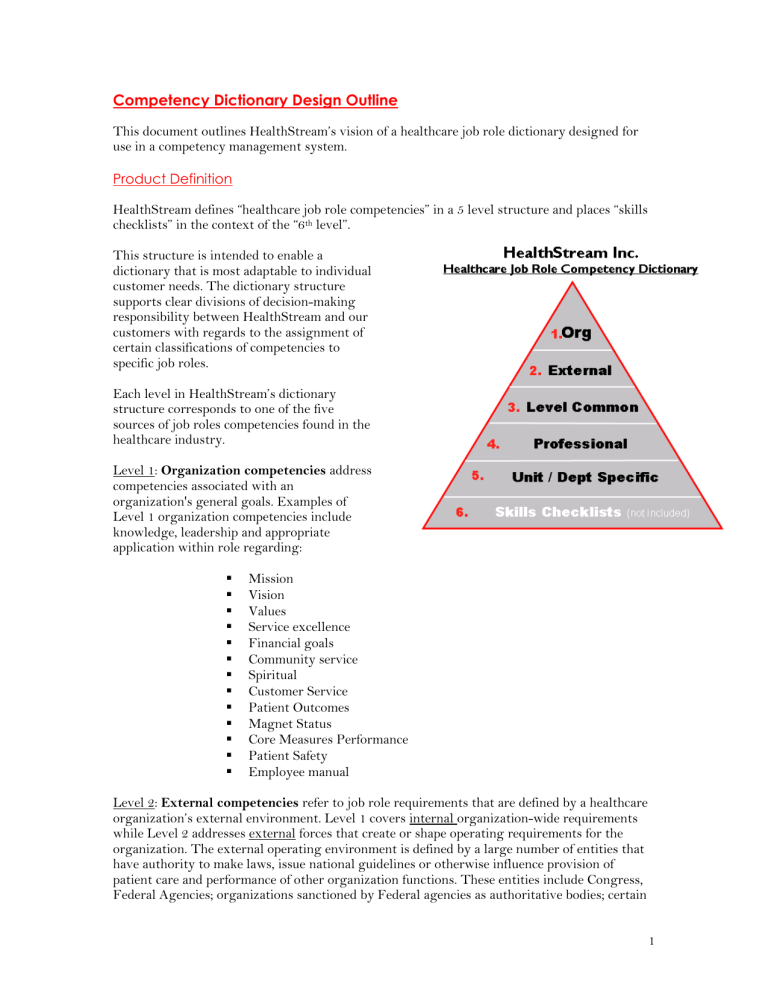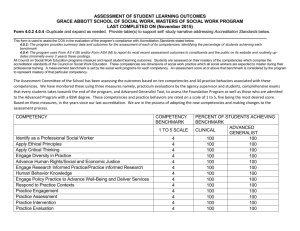Competency Dictionary Design Outline

Competency Dictionary Design Outline
This document outlines HealthStream’s vision of a healthcare job role dictionary designed for use in a competency management system.
Product Definition
HealthStream defines “healthcare job role competencies” in a 5 level structure and places “skills checklists” in the context of the “6 th level”.
This structure is intended to enable a dictionary that is most adaptable to individual customer needs. The dictionary structure supports clear divisions of decision-making responsibility between HealthStream and our customers with regards to the assignment of certain classifications of competencies to specific job roles.
Each level in HealthStream’s dictionary structure corresponds to one of the five sources of job roles competencies found in the healthcare industry.
Level 1: Organization competencies address competencies associated with an organization's general goals. Examples of
Level 1 organization competencies include knowledge, leadership and appropriate application within role regarding:
Mission
Vision
Values
Service excellence
Financial goals
Community service
Spiritual
Customer Service
Patient Outcomes
Magnet Status
Core Measures Performance
Patient Safety
Employee manual
Level 2: External competencies refer to job role requirements that are defined by a healthcare organization’s external environment. Level 1 covers internal organization-wide requirements while Level 2 addresses external forces that create or shape operating requirements for the organization. The external operating environment is defined by a large number of entities that have authority to make laws, issue national guidelines or otherwise influence provision of patient care and performance of other organization functions. These entities include Congress,
Federal Agencies; organizations sanctioned by Federal agencies as authoritative bodies; certain
1
professional practice organizations; State governments & agencies; local governments; patient advocacy groups; news media; etc.
Level 2 does not address entities that meet the definitions of either “vendor / supplier”,
“customer” or “patient”. Competencies related to these aspects of organization operations are be addressed in Level 4 and, for some roles, in Level 5.
Significant laws that affect organization operating policies are a product of some of these entities, such as:
HIPAA
COBRA
EMTALA
State laws regarding the identification and reporting of suspected domestic violence/abuse.
State laws regarding forensic evidence collection and reporting of apparent cases of rape, sexual battery, etc.
Relationship of competency dictionary Levels 3, 4 and 5 – example of RN competencies within
Med Surg units (not based on a specific hospital):
Level 3: Competencies common to organization level (“Level Common”) are competencies that exist across the same level of an organization and are common to most job roles within a particular level. For example, “director” level positions have common competency requirements around: maintaining staffing levels; departmental budgeting; expenditure management; performance evaluation process, etc. Level 3 competencies generally correlate to level of responsibility and to specific professions, such as RNs. “Level 3” describes universal, commonsense standards (such as requirements for department managers on staff management) or professional standards (common and generally accepted bodies of knowledge) that describe basic requirements independent of specific employer or assignment.
Level 4: Professional (“Service”) Competencies extend independent standards using certifications associated with particular job roles (e.g., nurse; accountant; pharmacist) as a guide, where appropriate, to define requirements within the general practice area of a specific assignment. For example, the Med Surg certification issued by the American Nurses
Credentialing Center (“ANCC”), the “Registered Nurse, Certified”, RNC, represented a body of knowledge on competencies specific to Med Surg patient care. These standards serve as foundation knowledge for other patient care areas but do not describe specialty requirements within med surge, such as: neurology; geriatrics; ICU step down (telemetry).
Level 5: Unit or department specific competencies identify those competencies that are specialized to job roles within specific patient care units, administrative areas or support departments. Continuing the RN example (expressed for Level 3 and Level 4), Level 5 provides additional RN competency requirements which are unique and specialized to the individual’s unit’s scope of practice.
This table illustrates the relationship of competency dictionary Levels 3, 4 and 5 using an example of RN competencies within Med Surg units (not based on a specific hospital):
Small Hospital Medium Hospital Large Hospital
2
Level 3
Level 4
Level 5
Level 5
Level 5
Level 5
Level 5
RN competencies based on professional standards
Med Surg competencies Med Su
Med Surg – oncology
Med Surg – orthopedics
Med Surg –
Telemetry
RN competencies based on professional standards
Med Surg competencies
Med Surg - oncology
Med Surg – orthopedics
RN competencies based on professional standards
Med Surg competencies
Med Surg - oncology
Med Surg - orthopedics
Med Surg -
Telemetry
Med Surg -Geriatrics
Med Surg -
Telemetry
Med Surg - Geriatrics
Med Surg - Hospice
Level 6: “Skills checklists” are descriptions of step-by-step procedures that are unique and particular to specific units, facilities or organizations. The competency requirements for performing a glucose test are expressed as a single sentence; however, a related skills checklist is likely three or four pages long. Customers have the options for incorporating their skills checklist within a competency definition as an MOV.
.
Product Boundaries
HealthStream defines six boundaries for its job role competency dictionary.
1.
HealthStream will not supply, enter or support skills checklist content.
Compass customers are solely responsible for the creation, input, proper use and application of all skills checklists.
2.
HealthStream’s competency dictionary addresses job roles, not job titles .
Organizations convert job roles (e.g. “Respiratory Therapist”) into job titles (e.g., “Respiratory Therapist I”; “Respiratory Therapist II”;
“Respiratory Therapist III”) based upon their own compensation policies, facilities, equipment and patient care emphasis. It is not possible for
HealthStream to extend standard job role competencies into “standard job title” definitions, there are simply too many permutations. This task rests with HealthStream’s customers, who have expertise in the unique operating requirements of their organizations, as reflected in job titles.
3
:
HealthStream’s customers should view HealthStream’s job role competency dictionary as content that is suitable for conversion into competency requirements expressed for job titles.
3.
HealthStream does not have the “insider knowledge” necessary to decide which specific job roles within a particular organization.
4.
All competency definitions are written to the “competent” level on the 5 step Benner scale. Customers are welcome to add additional information to define other levels of the Benner scale.
5.
The dictionary defines commonly known job roles found in patient care.
Larger organizations (in any industry) tend to develop more specialized and obscure roles. Such roles will not be addressed.
6.
Age-specific competencies (such as, differences in IV therapy competency requirements for providing care to an infant, vs. care provided to an adult) will not be included in job role specific competency definitions
4






